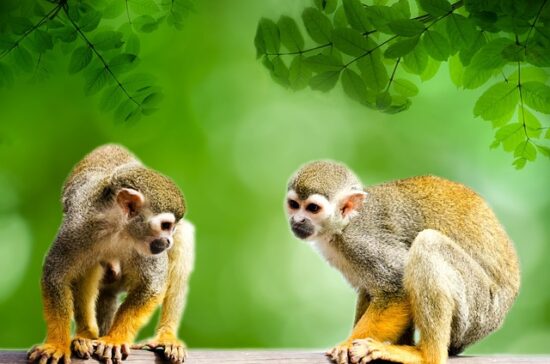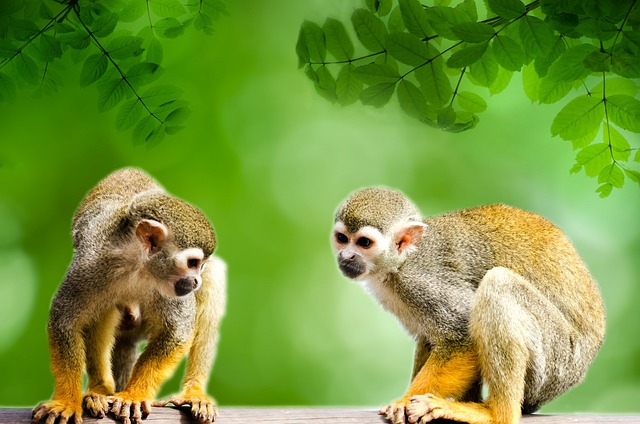The Amazon Rainforest is one of the most interesting places on Earth. These amazon rainforest facts for kids will give you an insight about its flora, fauna and its people. Amazon rainforest covers an enormous area in South America, roughly 7,000,000 square kilometres (2,700,000 square miles). It forms a jagged circle that has nine different countries in it. They are: Brazil; Peru; Columbia; Bolivia; Suriname; French Guiana and Venezuela. There are an estimated 16,000 tree species that make up a mass of about 390 billion individual trees. The Amazon Rainforest is so very important because, by its self, it is half of all the rainforest ecosystems in the world. The famous Amazon River runs through the rainforest.
Amazon Rainforest Facts For Kids
What is a Rainforest?
A rainforest is just as the name means: it is a forest that gets a lot of rain. The Amazon Rainforest receives an average of 250 centimeters (98inches) to 450 centimeters (180 inches) of rain every year. There are several things that all rainforests have in common. They usually have moderate climates that never get too cold. They can be very hot and humid. Most rainforests have layers of trees: very short to very tall. This is called stratified. There is basically four layer or strata of trees. Starting on the forest floor, there are small plants, along with tiny versions of what will be the forest giants. Next, in the strata is the understory. These trees are the homes for most of the rainforest’s animals. The trees in the understory are shrubs and bushes. The next layer is the canopy. These are the largest trees that give the rainforest a dense shade and create a thick tree cover. These trees are usually 30 meters (8 feet) to about 45 meters (148 feet) tall. Above the canopy is the emergent layer. These are the trees that have grown taller than the other trees in the canopy layer.
Animal Species in the Amazon
Amazon Rainforest is home to estimated 3000 species of fish; 400 species of amphibians, including the poison dart frogs; 378 reptile species; 1300 species of birds; 427 species of mammals, including Jaguar and Anteater; and at least 40,000 different plant species.
The rainforest is two different habitats that occupy the same area. There are some species that stay in the canopy layer and there or many species that stay on the forest floor and the understory. Coati, Monkeys and Toucan and among the species that stay in the canopy where they are safe from predators. The forest floor and the understory are home to deer, wild pigs and tapirs.
 Human History in the Amazon Rainforest – Amazon Rainforest Facts for Kids
Human History in the Amazon Rainforest – Amazon Rainforest Facts for Kids
Human history in the Amazon Rainforest can be traced to about 13,000 years ago. There are still signs of these early people. Anthropologist and archaeologist are professionals who dig for evidence of past people and study how they lived.
Francisco de Orellana was the first European to travel the Amazon River in 1542. He was amazed at all the people he found and was surprised that they were living in villages. The indigenous or native people were semi-nomadic surviving on hunting, fishing and gathering food from the rainforest. As more European people came to the rainforest many of the indigenous people began to die from diseases that had never come into contact with before.
Threat to Amazon Rainforest
There are many changes happening the Amazon Rainforest that is having terrible effects of the land, animals and people that live there. Climate change is threatening this unique area. One significant problem is that the Amazon Rainforest has been suffering from a drought starting in 2005. In moist, humid habitat that depends on large amounts of rain, drought can be very damaging.
Another problem is the amount of deforestation that is happening every day. Humans are cutting the canopy trees down or burning them to clear the land for growing crops and grazing livestock. With the canopy layer removed all life, the either lived in the canopy or lived under it is being disturbed. It is becoming very difficult for some of the animals to find the food and shelter they have depended on now that their habitat is so different.
The indigenous people who have lived in the Amazon Rainforest for thousands of years are also suffering as the landscape of their homeland is changing. In the past 40 years, it is estimated that 20% of the Amazon Rainforest has been cut down. Trees are being removed for two reasons. First the giant trees are very valuable to the logging industry. Mahogany and other unique hardwoods bring a very high price when they are exported and sold all over the world. The other main reason the trees are being removed it so the land can be used for farming and grazing. More land is needed all the time to feed a hungry world.
How to Save the Rainforest?
It is going to be very difficult to save the Amazon Rainforest for several reasons. There are 9 countries that share the rainforest and each one has a different policy in regards to deforestation; that is removing the trees for wood or to create more soy fields and grazing land for cattle. To save the rainforest there needs to be a cohesive policy that every country agrees to follow.
Currently, the land is valued for what can be taken from it. To protect the Amazon Rainforest, the value must be placed on the importance of leaving it as it has been for thousands of years. Money can be made for the local economies through tourism. People from all over the world are currently visiting the rainforests.
To save the Amazon Rainforest value must also be placed on how it functions as a “carbon sink.” A “carbon sink” is any land or forest that absorbs carbon from the atmosphere. The rainforest can create weather patterns and actually pull in extra carbon that is currently playing a major role in climate change. If the Amazon Rainforest continues to be removed and destroyed the overall conditions on Earth will become worse. By saving the Amazon Rainforest, we will be saving ourselves.
Share these amazon rainforest facts for kids with your class mates, friends and family.


Leave a Reply